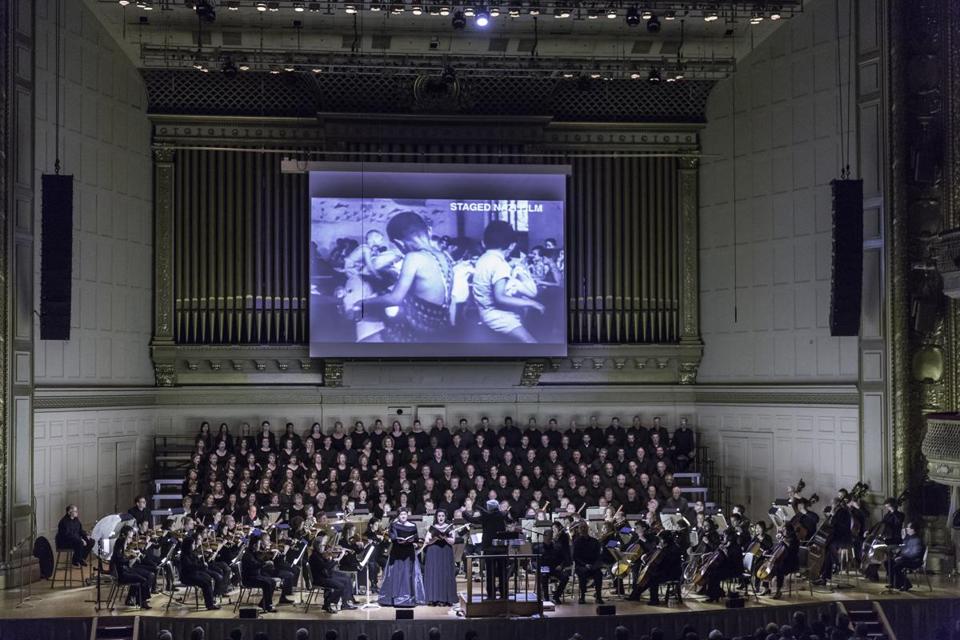 April 29, 2015
April 29, 2015
REQUIEM HERALDS COURAGE, PERSEVERANCE AT SYMPHONY HALL
By JEFFREY GANTZ
A performance of ‘Defiant Requiem: Verdi at Terezin’ at Boston’s Symphony Hall on April 27, 2015. Originally led by conductor Raphael Schachter, 150 Terezin inmates learned Verdi’s Requiem mass by rote, and performed it sixteen times. (photo credit: Michael J. Lutch)
“When the judge takes his seat, / whatever is hidden shall be made manifest, / nothing shall remain unavenged.”
Those words, from the “Liber scriptus” of the Catholic Mass for the dead, might have been uppermost in the minds of the detainees at the Nazis’ Terezín concentration camp who, between October 1943 and June 1944, gave 16 performances of the Verdi Requiem. On Monday at Symphony Hall, in a concert postponed from January, Murry Sidlin led the Orchestra of Terezín Remembrance and the Tanglewood Festival Chorus in a commemoration, “Defiant Requiem: Verdi at Terezín,” which interspersed the sections of the Requiem with film clips and narration by local actors Will LeBow and Jeremiah Kissel. The evening was as uplifting as it was sobering.
Despite the atrocious conditions — hunger, disease, torture, and the dire threat of “transport to the east” — the arts flourished at Terezín: lectures, art, plays, even opera. With just a vocal and piano score at his disposal, Rafael Schächter taught a chorus of 150 to sing the Verdi Requiem, an act of defiance and faith. Immediately after the first performance, more than half of his singers were shipped off to Auschwitz; he recruited new ones.
After the final performance, which the Nazis staged for the benefit of the Red Cross, Schächter himself was sent to Auschwitz. He did not survive, but his bunkmate, Edgar Krasa, did. Krasa, who now lives in Newton, had sung in all 16 performances at Terezín. Here, his sons Daniel and Raphael and his grandson Alexander sang with the Tanglewood Festival Chorus.
Since its 2002 premiere, “Defiant Requiem” has been presented more than 30 times in the US and Europe, including three times in Terezín. Monday’s performance began with a video-screen photo of the camp entrance, the slogan “Arbeit macht frei” on the arch, followed by video testimony from Krasa and other survivors who sang in Schächter’s chorus. Sidlin offered a brief introduction to Terezín, and after a flurry of Jewish music that included a snatch of “Bei mir bistu shein,” the Requiem began.
The performance was full of character, now gentle and tender, now anguished and despairing. Here and there Vytas Baksys’s piano replaced the orchestra, in tribute to the Terezín performances. Sidlin and Kissel provided narration; LeBow portrayed Schächter.
The soloists — soprano Aga Mikolaj, mezzo-soprano Ann McMahon Quintero, tenor Marc Heller, and bass Nathan Stark — were fervent, but the star was the chorus, heaven-storming in the “Dies irae” and “Rex tremendae” and “Sanctus.” The “Agnus Dei” was accompanied by silent footage from a Nazi propaganda film depicting Terezín as a happy Jewish resort village. Another chilling moment came in the concluding “Libera me,” Mikolaj soaring on the “Requiem aeternam” over the lulling chorus.
But nothing could have been more moving than the evening’s end. The final image on the video screen was Hana Krasa, Edgar’s wife, who died on April 13. The orchestra members got up and left as Bruce Creditor’s clarinet played “Oseh Shalom,” the Hebrew prayer for peace. Concertmaster Herbert Greenberg took up the tune as the chorus, humming it, exited down the Symphony Hall aisles. A minute of silence was requested in lieu of applause; the audience observed the minute, then applauded anyway.

